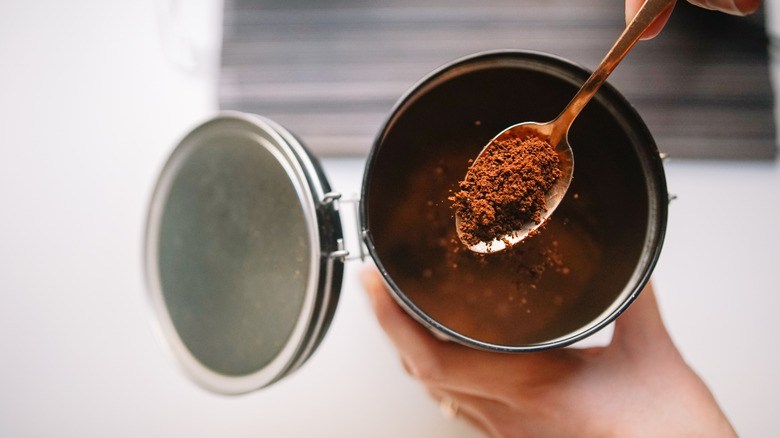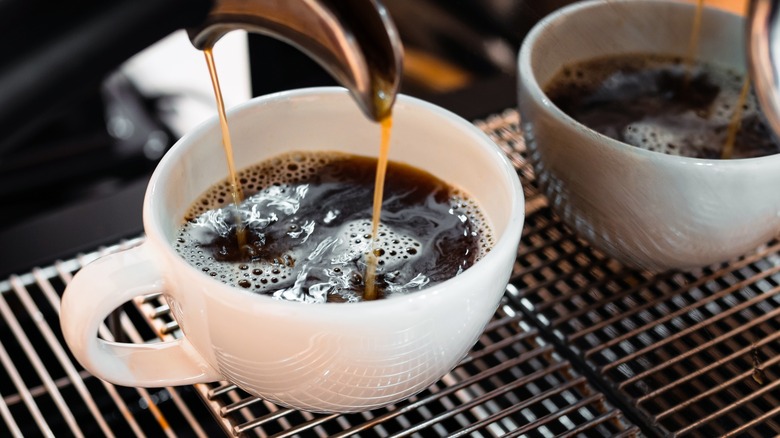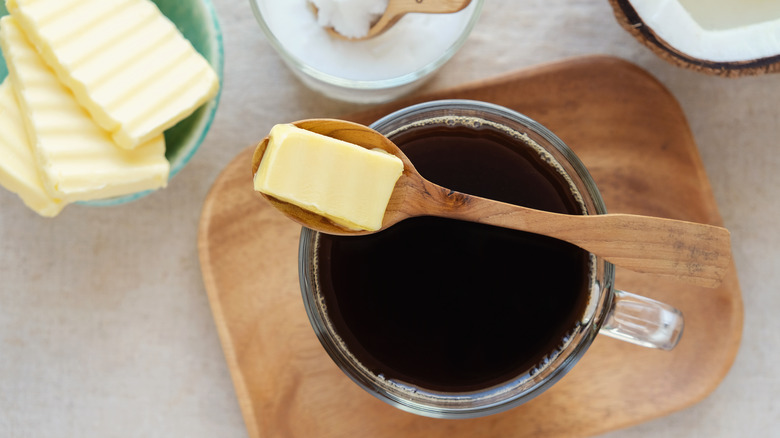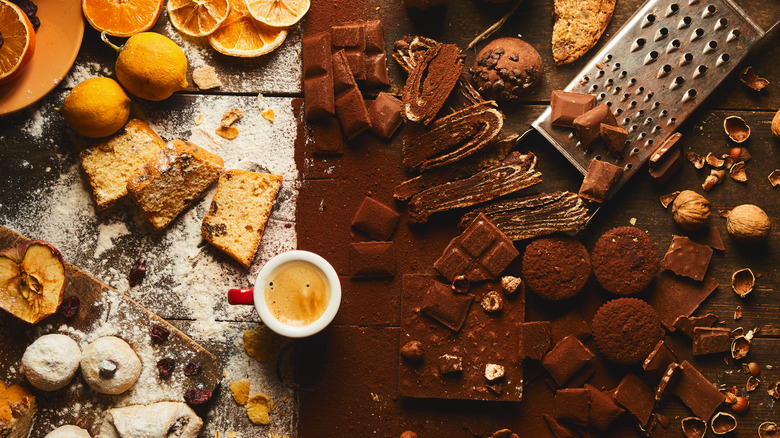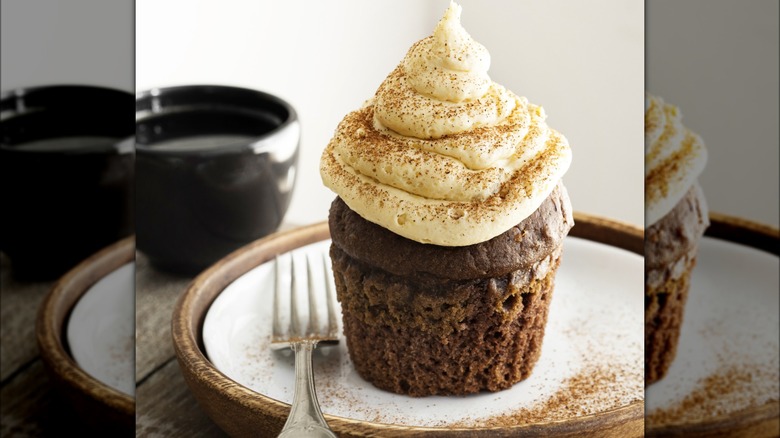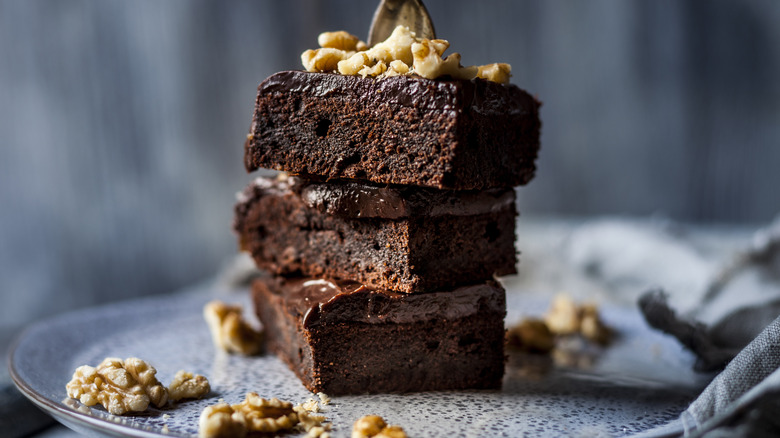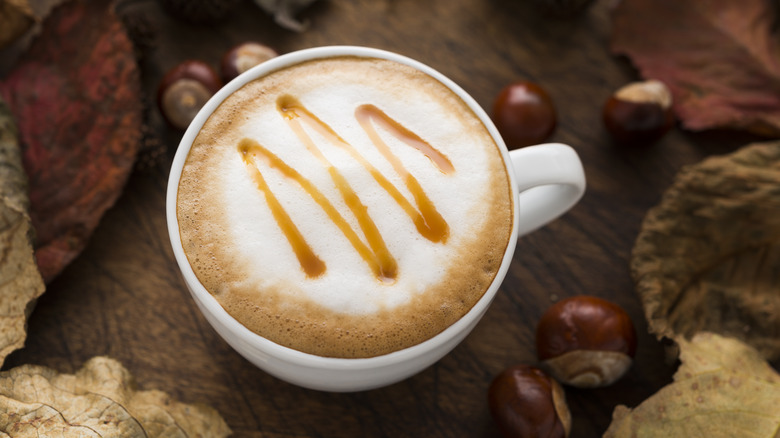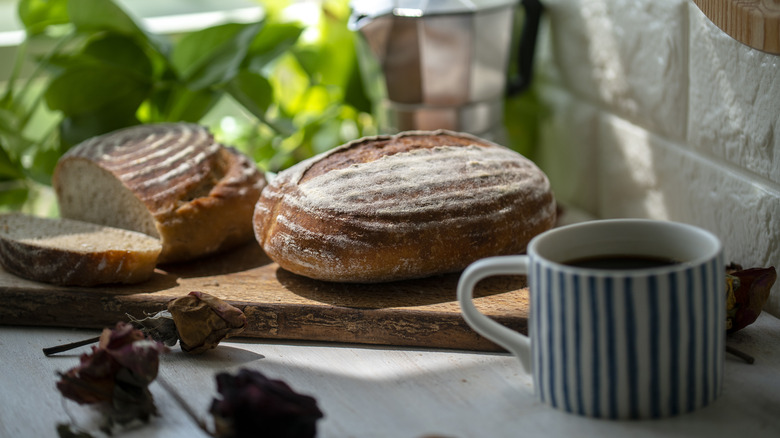The Ultimate Guide To Baking With Coffee
We may receive a commission on purchases made from links.
Even the novice baker knows that baking is a precise science — making changes to a recipe is often not as easy as a simple substitution. In the chemistry of baking, every gram of every ingredient matters, and the tiniest change can make or break even the simplest of bakes. That being said, baking is also meant to be fun, and it's natural to want to experiment with even your favorite tried and true recipe. If you've ever scoured the web for tips on making your recipes pop, you've probably run into some common tips, such as using a couple of extra teaspoons of vanilla, adding sour cream into scones, or incorporating coffee into your brownie recipe.
The simple addition of coffee can elevate a lot of recipes. Coffee complements many flavors, like chocolate, whiskey, vanilla, and cinnamon, and while some recipes already call for coffee — take coffee coffee mini pavlovas, for example — those that don't may benefit from the slight flavor kick. If you ever find yourself wanting a hint of the caffeinated beverage in your bakes, there's almost certainly a way to pull it off — but not without considering several factors. As a baker and specialty coffee barista, baking with coffee is one of my favorite ways to enhance my bakes, and I've spent a lot of time (and plenty of trial and error) figuring out the best ways to use coffee to boost my bakes without breaking them.
Decide whether to use powder, brew, or extract
When you're considering baking with coffee, the first thing you'll need to decide is which type of coffee to bake with: Instant coffee powder, brewed coffee, or coffee extract. If you're following a recipe that already includes coffee, it's best to use the type of coffee the recipe calls for. If you're adding coffee to an existing recipe, consider the qualities of the recipe you're adding it to before choosing which coffee to use. If you're adding coffee to a wet recipe, like a batter or sauce, you may find it best to add brewed coffee; if, on the other hand, you don't want your recipe to be too wet, you may choose to use instant coffee powder.
While instant coffee powder and brewed coffee are the most accessible options, there is another option that I find to be the easiest way to add coffee flavor to a recipe: Coffee extract. Coffee extract, similar to vanilla extract, is an extremely concentrated, potent form of the flavor; and, similar to vanilla extract, a tiny bit packs a powerful punch. My favorite coffee extract to use when baking is Trablit Coffee Extract. The first time I experimented with adding this extract to a recipe, I added 1½ teaspoons to a sponge cake recipe, and I found that to be nearly too much. If you decide to grab a bottle of this extract, I recommend adding ½ teaspoon to start.
If you're using brewed coffee, make it strong
If you're using brewed coffee in a recipe, you'll need to be mindful of the amount of moisture it will add to your recipe. To get that coffee flavor to pack a punch without adding too much liquid, put some thought into the type of brew you'll want to use. Light roasts (though my favorite coffee to drink) won't cut it here, nor will your naturally processed, fruit-forward Ethiopian coffee. Rather, when you're brewing coffee to bake with, reach for the dark stuff.
The darker and stronger, the better — at least when it comes to baking with coffee. A French roast is a great coffee to bake with. Though it may be too strong for you to ever drink it black, that potency is what you need for the coffee to come through in your recipe. In addition to getting a darker roast, I also recommend brewing it stronger than you normally would. If you're using an automatic brewer, go ahead and fill the basket with however much coffee you'd usually put in for your morning cuppa, and then cut the amount of water by half. The result will be an incredibly strong coffee, and you won't need to use as much coffee in your recipe to pack in that flavor.
Try adding coffee infusions for subtle coffee notes
It's understandable to be nervous about adding coffee to a recipe, especially if you don't have much experience baking with the brew. If this is the case, it might be more comfortable to incorporate the coffee flavor into an already existing ingredient via an infusing process. It's simple enough to infuse pretty much any liquid in your recipe with coffee. This is an especially good option to go for if you want the coffee flavor to be slightly subtler and enhance your other flavors rather than overpowering them.
You can infuse almost any liquid ingredient in your recipe with coffee, including milk, cream, and even butter. To infuse coffee into milk or cream, I recommend measuring out slightly more liquid than your recipe calls for, to account for both evaporation and any liquid the coffee will absorb. Bring it to a simmer on the stove; then, add whole coffee beans or coffee grounds (more if you want a stronger infusion, less if you want a weaker one). Let them simmer together for about five minutes, and then remove the mixture from the heat, cover it, and let it come to room temperature (depending on the amount of liquid, this may take up to an hour or longer, so plan accordingly). Then strain the liquid from the coffee, using a fine-mesh strainer if using coffee grounds. Re-measure your liquid and add it to your recipe as you normally would.
Know when to add coffee to your recipe
The order in which you add ingredients to your recipe matters. For example, if you don't cream together butter and sugar at the beginning of making a batch of cookies, you'll end up with a dense, heavy end product. Add chocolate chips too late and you'll over-mix your cookie batter, resulting in tough cookies. These are all important factors to account for when adding coffee to a recipe, especially if the recipe doesn't call for coffee to begin with.
It will be easy to decide when to add your coffee if you're using an infusion; simply add the infusion when the recipe calls for the base liquid. Otherwise, I've found it best to add your coffee when mixing together ingredients of the same type. For example, I would add instant coffee powder as I'm mixing my dry ingredients together, brewed coffee when I'm blending my wet ingredients, and extract when incorporating eggs and any other flavorings. Regardless of when you decide to add coffee into your recipe, I have one simple tip that's saved me time and time again: Write it down. When baking, especially when following a written recipe, it's easy to go on autopilot — before you know it, your bake is in the oven and you've completely forgotten your coffee ingredient! Writing down the step to add your coffee will help you actually remember to add it in when it's time.
Use coffee in fillings and frostings
It's very reasonable to have some hesitations around altering a tried and true bake, especially if you're new to experimenting with baking. Fortunately, there's an easy workaround here, and it doesn't involve altering your base recipe at all. To incorporate a coffee flavor without compromising the integrity of your bake, consider including it in an icing, frosting, filling, or other garnish. Even if it doesn't work on your first try, a frosting is generally easier to re-make than a base recipe, making it less distressing if you feel you've messed it up.
How you add coffee to your filling or frosting will likely depend on the recipe you're making. If I'm making a thicker buttercream frosting, I like to add a dash of coffee extract after creaming the butter, at the same time as I add my heavy cream. You could infuse the heavy cream if you want a subtle coffee flavor, but since thick frostings will use a smaller amount of liquid, an infused liquid may not bring out as much flavor as you want. Maybe you want to top a bake with some chocolate sauce; in that case, you can add instant coffee powder to melting chocolate for a simple flavor infusion. Or, perhaps you only want the slightest hint of bitter coffee to offset the sweetness of your bake. Grab some espresso powder and a fine-mesh sifter, and give the top of your finished baked good a fine espresso powder dusting.
Add coffee to chocolate desserts
There's one area of baking in which you should definitely use coffee if you aren't already: Chocolate bakes. Coffee and chocolate are a seriously underrated baking pairing, in my opinion, and I don't know why every chocolate recipe doesn't call for at least a little bit of coffee as well. Don't believe me? Then take a note from the Queen's book; some of Queen Elizabeth's favorite desserts combined coffee and chocolate. I've been adding leftover morning coffee to brownies since I was a kid, and my brownies have always gotten compliments for it. While I'm a bit more methodical now and don't just go adding leftover coffee to any recipe, my point still stands: Coffee makes chocolate taste better.
When adding coffee to a chocolate bake, don't feel like you need to taste the coffee flavor. Even the smallest bit of coffee can go a long way in enhancing the chocolate flavor in your bake, and you'll end up with a much richer, fuller end product. If you're incorporating coffee into a wetter batter, like a cake recipe, hot coffee will make the best chocolate cake. To avoid scrambling the eggs in your recipe, add the hot coffee in as the last step of mixing the batter, and make sure the rest of your batter is at room temperature before incorporating the hot liquid.
Popular coffee flavor pairings
While coffee enhances chocolate without overpowering it, coffee can also complement other flavors to create rich, delectable pairings that can elevate your dessert to a whole new level. I like to consider coffee flavor pairings when I'm adding coffee to a recipe, as it may encourage me to add other flavors the recipe doesn't necessarily call for. For example, I made a coffee sponge cake one time that was too powerful for the simple whipped cream filling the cake called for. I wasn't happy with the result, so I remade the coffee sponge, turned the whipped cream filling into a slightly heavier cinnamon crème diplomat, and added a drizzle of homemade whiskey caramel on top. The result? A delightfully well-balanced dessert that packed a punch, in which all the flavors were well-balanced and shone in their own way.
My advice? Play with flavor combinations and see what you like tasting with coffee. If you've ever put cinnamon ice cubes into iced coffee, you're already familiar with creative coffee flavor experimentation. You might find yourself wanting to fill a coffee cupcake with a raspberry jam, or garnishing a coffee-flavored cake with a peanut butter drizzle. Consider the strength of your flavor pairings when you're planning your bake. Because whiskey is a strong flavor, I chose to incorporate it into a caramel drizzle so it wouldn't overpower the coffee sponge.
Consider replacing water with brewed coffee in breads
Bread bakers out there, this one is for you: If you want to coffee-ify your favorite bread recipe, try replacing water with coffee in equal parts. Because bread (especially yeasted bread) can be finicky and coffee adds a whole different element to your bake, remember to be patient, and that it's okay to make mistakes. I'm a sourdough baker who's substituted water for coffee and experimented with adding coffee extract to my breads to varying degrees of success. If anything, I've found that using coffee in my sourdough bakes slightly slows down the fermentation and can tighten the crumb of my end product.
A Food & Wine interview with Melanie Wanders, Research & Development Specialist at King Arthur, also discusses how using coffee in yeasted bread can affect the dough structure in a good way. She says, "Coffee's slightly acidic pH most likely accounts for the bread dough being easier to work with because gluten networks strengthen in slightly acidic environments." When experimenting with a rye bread recipe, Wanders reported that using coffee instead of water led to the bread having a "better rise, crumb structure, and even toasty and well-browned crust with delicious bitter notes." The bottom line is that you should be willing to experiment with incorporating coffee into your yeasted doughs. My best advice is to take copious notes while you're testing a recipe, so you have them to refer to when you want to make alterations.
Use coffee in the crust
Are you making a pie, cheesecake, crumble, or other recipe that you want to give a hint of coffee flavor? Rather than incorporating coffee into your base recipe, try giving your crust or crumble a caffeinated twist. I wouldn't recommend using brewed coffee or even espresso extract for this tip, as you don't want a crust or crumble to be very moist. Rather, try adding instant coffee to a crust or crumble for a subtle hint of coffee that won't overpower the rest of your bake.
Make sure you're using fine-ground instant coffee powder rather than coffee or espresso grounds when you're incorporating them to your crust; otherwise, your finished product will be gritty and unpleasant. Instant coffee, however, will incorporate more seamlessly. If your crust or crumble calls for melted butter, I recommend using the above tip of infusing the melted butter with coffee prior to combining it with the other ingredients. If the rest of your bake boasts pretty simple flavors — say, if you're making a plain cheesecake — don't use too much coffee in the crust, as you'll run the risk of overwhelming the rest of your bake.

